GUTENBERG BIBLE
Once someone figures out that I am not working on the problem of global warming, then next question is usually “What is the oldest thing you have worked on?” followed by “Have you ever worked on a Gutenberg Bible?” As of 2007, I can answer in the affirmative to the latter question.
I worked on the Book of Revelation. It is known as one of the “Noble Fragments” and currently owned by the Rare Book and Manuscript Library of Columbia University. According to Eric White (email correspondence), this copy was owned by Princess Maria Elizabeth Augusta von Sulzback of Bavaria, 1721-1794. It was at the Mannheim Hofbibliothek and later the Staatsbiliothek in Munich, where it was sold as a duplicate in 1832 to Baron Curzon of Zouche. It remained with his decendants until around 1920 and it was sold to a dealer named Gabriel Wells, who broke it up. At that time it was missing 53 leaves. White and Paul Needham have a census of 370 leaves, which means there are 220 missing. Stikeman and Co. bound these “Noble Fragments” in a dark blue goatskin, silk doublures and leather joints.
During the examination, I noticed a burn mark that didn’t match up on the next leaf.
As I examined this page more closely, I discovered that not only the initial letter, but the text on the 15 last lines were handwritten. It seems that because Gutenberg was trying to imitate handwriting, and did it so well, it was possible for handwriting to imitate the text. On closer examination, the ink sat on the page differently, and under transmitted light the “Restoration” (Forgery?) became apparent. According to Eric White, 96 of these initials have been replaced. I was thankful this belonged to an institution, not a private collector.
As is typical with poor quality of 20th C. Levant goatskin, and this type of binding structure, the boards had become detached. Because of the large,thick and heavy boards, deteriorated covering leather, leather joints and relatively thin textblock, this was a perfect candidate for board slotting.
The rest of the treatment consisted of surface cleaning the text, performing some minor paper repairs, relining the spine and reattaching the boards, using my board slotting machine.
Above: Before Treatment
Above: After Treatment
The hinge from the board slotting was toned with acrylics. It tends to be a very honest treatment, none of the original material is covered or information obscured by lifting– the treatment of the the surface of the leather, lacing patterns, etc. Slotting is also excellent when dealing with leather joints. Board slotting has the reputation of being more of a circulating collections repair here in the USA (which it certainly can be adapted to), whilst in England it tends to be used on more rare materials. Chris Clarkson originally invented board slotting to deal with structures like this one.
This is a closeup of the slotted area. I find it tends to resemble a scar that has healed.
As A. Edward Newton, in the printed introduction to these “Noble Fragments” relates, a Mr. Stevens added the following note when this book was originally brought into the US:
“Pray, Sir, ponder for a moment and appreciate the rarity and importance of this precious consignment from the old world to the new. Not only is it the first Bible, but it is the first book ever printed. It was read in Europe half a century before America was discovered. Please suggest to your deputy that he uncover his head while in the presence of this great book. Let no Custom House Official, or other man in or out of authority, see it without first reverently raising his hat. It is not possible for many men ever to touch or even look upon a page of a Gutenberg Bible”
Indeed, it was an honor to work on this important book. The treatment involved an interesting combination of state of the art 15th C. technology (movable type) meeting state of the art 21st. C. technology (board slotting).
CREDIT: Thanks to the Rare Book and Manuscript Library of Columbia University for allowing me to reproduce this information.
On 2 September 2008 Thomas Conroy added:
My recollection, for what its worth, is that two copies of the Gutenberg Bible were broken up in the 1930s, not just one. That bastard Gabriel Wells broke his up into individual leaves; with, of course, the book breaker’s invariable whine that it was “damaged” because it was missing 53 leaves; missing only 53 leaves meant that it was one of the most complete surviving copies. Until he got his claws on it.
The other copy was much less complete, and it was broken up into much larger chunks— into complete books of the bible when possible. Since you worked on a Book of Revelation and could look at sequential pages, this must have been the copy referred to by “noble fragments”— with the not-so-subtle suggestion that Wells had acted ignobly. The Stikeman binding must have been done very near the end of the firm; I forget the year that it was closed down by Morris Kalaba, who had taken Stikeman over in the early 1920s, but it was sometime in the middle 1930s.

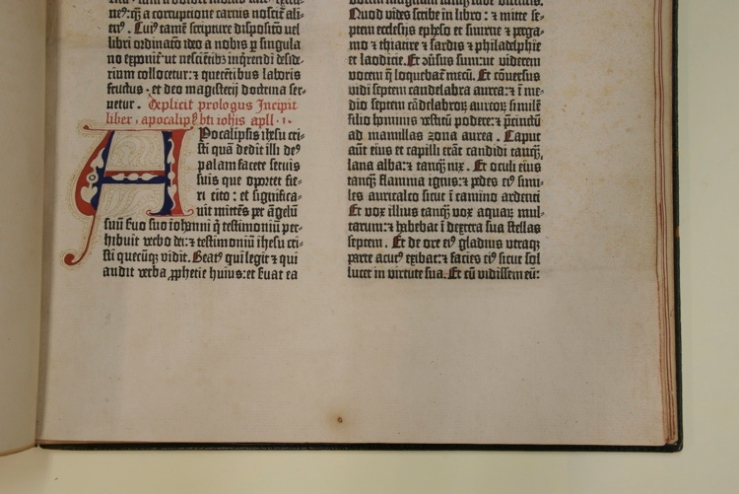
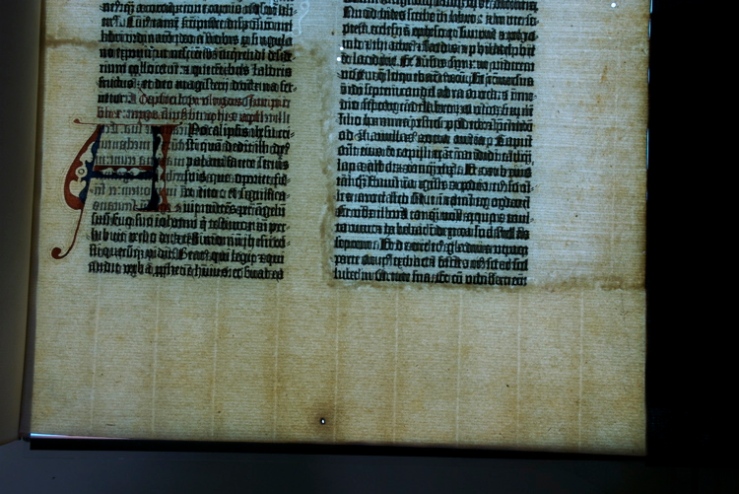
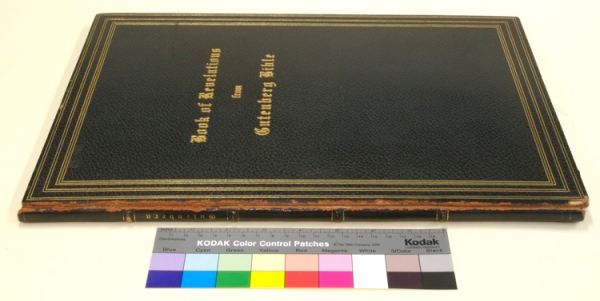
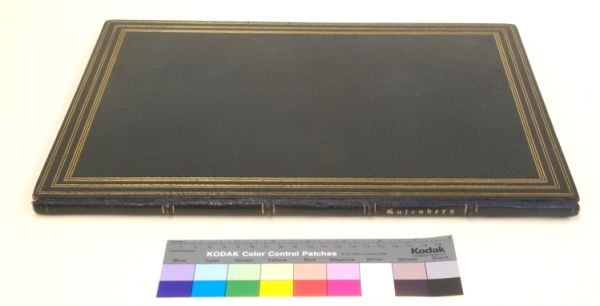
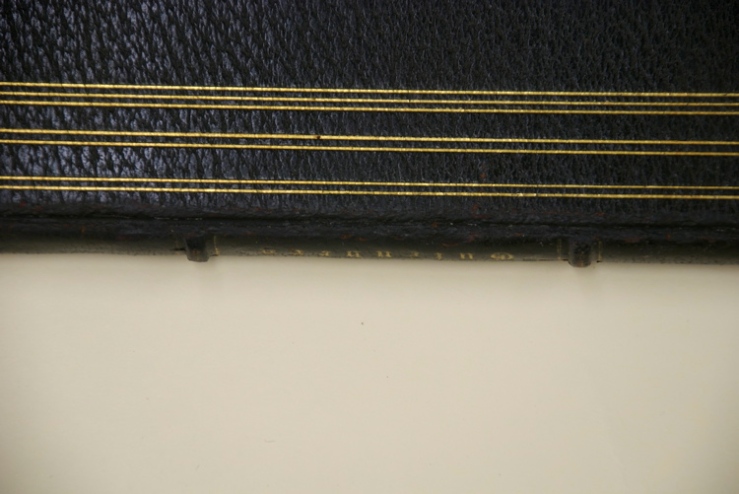
Jeff, nice website. This “Noble Fragment” is similar to one we had in Greensboro. The initial, I think it was an “A” as well, had been “restored.” I’ll have to see if I have an image of it, as the style of the restoration in your leaf looks very familiar. What an interesting history these Noble Fragments have had.
Hi, Jeff,
I found at least one of my sources of information, Paul Needham’s census of copies of 1985 (several others have been done since) and as so often happens when I rely on memory, I must correct some details. The second copy of the Gutenberg Bible broken up in the 20th Century was the “Trier Copy” broken up by Scribners’ Bookshop in 1954. The largest fragment, the entire New Testiment lacking 14 of 130 leaves, ended up in the Lilly Library and is still counted as a copy by some (not all) censuses. The location is known for sections of 31, 28, and 10, leaves; 65 more are missing.
“Noble Fragments” (spit to get the taste out of my mouth) was indeed Gabriel Wells’ own term for his very ignoble exercise in greed. All the few copies of the leaf book which I have seen were of one leaf only, with (if I remember correctly, but we have seen what that is worth) the leaf loose in a portfolio, and my impression was that all the copies were of one leaf. I was completely wrong in this.
Tom
Thanks Tom. As always, your breadth of knowledge is remarkable. Jeff
Interesting story about the “Noble Fragments”. I’d heard the story about Wells breaking up some fairly complete copies, and selling them off, with Stikeman&Co. NY, as the binder. Have seen a couple myself in my researching the bindery, but never dared get closer than arm’s length. Thank you for the in-depth story behind your repair work. I especially find the comment regarding the quality of the Levant interesting. I have encountered bindings in otherwise fine condition whose boards have come entirely loose. On the surface the leather is wonderful, but I wondered whether it was acid (from the dye) that made it crumble. Seems it’s not always just the sunned or dried bindings where the boards have come loose.
Also find Mr. Conroy’s knowledge of the bindery of interest. His knowledge of the Kalaba brother’s involvement is encouraging. Most folks I encounter in my (limited) research have barely known of the firm, let alone the managing partners…
If possible, I’d appreciate the chance to speak (or email, of course) with either of you, if you have any information about the bindery which you’d like to share. And vice versa… I might (though I doubt it) be able to help you in some regard.
I also have a few Stikeman bindings that might need some work (hinges starting, one with a free board, etc.) and I’d be interested in knowing if you’d do the work.
Best, and thanks again for the great read.
J. Stikeman
I’ll bet Tom knows quite a bit more about the firm. The little I know is in the article. I’d be interested to examine the Stikeman bindings, and of course propose a couple of treatment options.
Gutenberg B-42 line Bibles. How they were really printed, without the use of metal punches; metal matrices; metal type or any adjustable casting apparatus. Go to:- gutenbergsecrets.co.uk/
Jeff-My Museum has a Noble Leaf. Written in pencil on one of the blank pages is “In KIng James Version 2 Chronicles 6.7.” Which I have always interpreted as meaning our page contained these verses. But if all Noble Leaves were from a Volume Two, it seems this page would have to be from a later book, or the books were not in the order we use today. Can you help me with that?